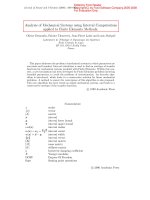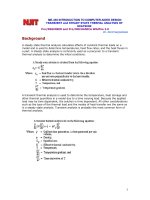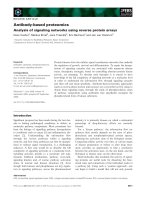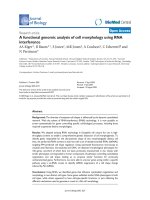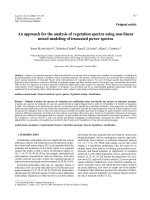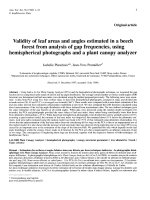Static thermal analysis of fins models using ansys
Bạn đang xem bản rút gọn của tài liệu. Xem và tải ngay bản đầy đủ của tài liệu tại đây (659.95 KB, 12 trang )
International Journal of Mechanical Engineering and Technology (IJMET)
Volume 11, Issue 2, February 2020, pp. 10-21, Article ID: IJMET_11_02_002
Available online at />ISSN Print: 0976-6340 and ISSN Online: 0976-6359
© IAEME Publication
STATIC THERMAL ANALYSIS OF FINS
MODELS USING ANSYS
Rajat Kumar
Department of Mechanical Engineering,
Sachdeva Institute of Technology Farah Mathura Uttar Pradesh,
Dr. A.P.J. Abdul Kalam Technical University, Uttar Pradesh, India
Devendra Singh
Assistant Professor, Sachdeva Institute of Technology,
Farah Mathura, Uttar Pradesh, India
Ajay Kumar Sharma
Assistant Professor, Institute of Engineering and Technology,
Lucknow, Uttar Pradesh, India
ABSTRACT
The Engine chamber is one of the essential engine components, that is subjected to
over the top temperature differences and thermal stresses. Fins are set on the surface
of the cylinder to improve the quantity of heat exchange by convection. When fuel is
burned in an engine, heat is produced. Additional heat is also generated by friction
between the moving parts. In air-cooled I.C engine, extended surfaces called fins are
provided at the periphery of engine cylinder to increase heat transfer rate. That is why
the analysis of fin is important to increase the heat transfer rate. The main of aim of
this work is to study various researches done in past to improve heat transfer rate of
cooling fins by changing cylinder fin geometry and material. In the present work,
Experiments have been performed to discover the temperature variations inside the
fins made in four kind geometries (plate Fins, Circular Pin fins, plate fins with holes,
and draft Pin fins) and consistent state heat exchange examination has been studied
utilizing a finite element software ANSYS to test and approve results. The temperature
variations at various areas of fins models are evaluated by FEM and compared
models of fins performance by heat flux and temperature variations obtained by
experimentally in Analysis. The principle implemented in this project is to expand the
heat dissipation rate by utilizing the wind flow. The main aim of the study is to
enhance the thermal properties by shifting geometry, material, and design of fins.
Keywords: Heat transfer, extended surfaces, Thermal analysis, and FEM, Analysis
and Heat transfer enhancement.
Cite this Article: Rajat Kumar, Devendra Singh and Ajay Kumar Sharma, Static
Thermal Analysis of Fins Models Using Ansys. International Journal of Mechanical
Engineering and Technology 11(2), 2020, pp. 10-21.
/> />
10
Static Thermal Analysis of Fins Models Using Ansys
1. INTRODUCTION
In normal cause, larger parts of an engine remain exposed to the atmospheric air. When the
vehicles run, the air at certain relative velocity impinges upon the engine, and sweeps away its
heat. The heat carried-away by the air is due to natural convection, therefore this method is
known as natural air-cooling. Engines mounted on 2-wheelers are mostly cooled by natural
air. As the heat dissipation is a function of frontal cross-sectional area of the engine, therefore
there exists a need to enlarge this area. An engine with enlarge area will becomes bulky and in
turn will also reduce the power by weight ratio. Hence, as an alternative arrangement, fins are
constructed to enhance the frontal cross-sectional area of the engine. Fins (or ribs) are sharp
projections provided on the surfaces of cylinder block and cylinder head. To avoid
overheating, and the consequent ill effects, the heat transferred to an engine component (after
a certain level) must be removed as quickly as possible and be conveyed to the atmosphere.
The heat exchange from surfaces may, in general, be enhanced by expanding the heat
exchange coefficient between a surface and its environment, by expanding the heat exchange
zone of the surface, or by both. In most cases, the region of Heat exchange is expanded by
using extended surfaces as balances the fins joined to walls and surfaces. Expanded surfaces
(fins) are much of the time utilized in heat exchanging devices to increase the heat exchange
between an essential surface and the surrounding liquid. Different types of fins, going from
moderately simple geometries to complex geometries have been utilized. A shape of the
regular fins geometries is rectangular, triangular, cylindrical, trapezoidal etc. For the guideline
of conduction, convection, radiation of a fin arrangement optimized the quantity of heat it
exchanges Increasing the temperature contrast between the fin setup and based upon
surroundings, marginally expanding the convection heat transfer coefficient, or somewhat
expanding the surface region of the fin design of the object enhance the heat exchange. This
can be achieved by faster heat dissipation. By using the extended surfaces (Fins) we can
improve the heat transfer rate from engine cylinder. For this analysis of the heat transfer rate
of the fins is imperative. Every combination of shape, size and material have their own
efficiency thereby selecting the best possible combination which give maximum efficiency to
get required heat transfer rate for maximum engine efficiency. Extended area on the cylinder
surfaces is use to increase the surface area in contact with the fluid flowing around it.
2. EXTENDED SURFACES (FINS)
In the Heat exchange study, the surface that extruded out from a base is known as a fin. fins
are utilized to enhance the rate of heat dissipation from or to the environment by expanding
the rate of convection. The all of convection, conduction, or radiation of an object chooses the
rate of heat it transferred. It increments with the distinction of temperature between
surroundings and the object, additionally expanding the convection coefficient of heat
exchange, or expanding the surface region. But, increase of the area also causes increased
resistance to the heat flow. Hence, coefficient of heat transfer is based on the total area (the
base and fin surface area) which comes out to be less than that of the base. There are different
types of shape and size fins used in engineering applications to increasing the heat transfer
rate such as
Rectangular fins
Triangular fins
Trapezium fins
Circular segmental fins.
Different shape and designs of fins are used in different situations.
/>
11
Rajat Kumar, Devendra Singh and Ajay Kumar Sharma
Figure 1 Cylinder with fins
(Source: Ahirwar et al. 2018).
3. MATERIAL PROPERTIES OF FINS MATERIAL
Thermal analysis of Fins performed by using Aluminum alloy of the Fins material.
Composition of Aluminum alloy is shown in Table 1.
Table 1: Material properties of Fins Model
Parameters
Unit
(Kg/m3)
(MPa)
(1/K)
(GPa)
(MPa)
(W/m/0C)
Density
Young's Modulus
Coefficient of thermal expansion
Poisson's Ratio
Elastic modulus
Ultimate Tensile Strength
Thermal conductivity
Aluminum alloy
(1060)
2700
69000
2.3 × 10-5
0.33
70
310
200
4. DESIGN AND ANALYSIS OF FINS
4.1. Modeling of Fins Model
Fins models designed with the material selection of aluminum alloy 1060 and three Fins
model designed here i.e. plate Fins, Circular Pin fins and Rectangular pin fins. Fins model
with plate fins and pin fins in type of circular and rectangular holes pin fins fins for passing
air through fins. FEM analysis performed through Ansys. The practical use of finite element
modeling is known as FEA which is best understood during the real problem solving. FEA
has been broadly utilized by the automotive business. It is an extremely prominent instrument
for configuration builds in the product development technique. It is imperative to comprehend
the FEA basics and design technique, demonstrating systems, the inherent mistakes and their
impacts on the nature of the outcomes to render FEA as an effective design tool. FEA is also
used as a computational tool for carrying out engineering problem analyses.
/>
12
Static Thermal Analysis of Fins Models Using Ansys
Figure 2: Plate Fins Designed Model in Ansys
Figure 3: Rectangular Pin Fins Designed Model in Ansys
Figure 4: Circular Pin Fins Designed Model in Ansys
Figure 5: Draft Pin Fins Designed Model in Ansys
4.2. Applying Boundary Conditions
Figure represents the applied boundary conditions on Fins Model has Heat Flow 13 W, and
convection conditions 22 0c while convection on the top surface of the Fins has been applied,
to optimize Maximum and minimum temperature also optimize maximum heat flow rate for
high heat transfer. Figure shows the applied boundary conditions of Fins Model.
/>
13
Rajat Kumar, Devendra Singh and Ajay Kumar Sharma
Figure 6: Applied Boundary conditions on Plate Fins
Figure 7: Applied Boundary conditions on Rectangular plate Fins with holes
Figure 8: Applied Boundary conditions on Circular Pin Fins
/>
14
Static Thermal Analysis of Fins Models Using Ansys
Figure 9: Applied Boundary conditions on Draft conical Pin Fins
5. RESULTS AND DISCUSSION
The Fins model to research is subdivided into a mesh of limited measured components of the
basic frame. Inside every segment, the distinction of displacement is thought to be computed
by basic polynomial profile capacities and nodal Temperature. Conditions for the strains and
stresses are created as far as the obscure nodal temperature. From this, the conditions of
balance are collected in a grid shape which can be easily customized. Temperature variation
across various Finsmodels in steady state condition shows and boundary conditions applied
shown in figures Maximum temperature at top. After processing solution, the Temperature
and Total Heat Flux in thermal analysis compared with the plate Fins, Circular Pin fins, and
plate fins with holes, draft Pin fins. These results as part of structural and thermal analysis are
obtained for all three conditions i.e. plate Fins, Circular Pin fins, plate fins with holes, and
draft Pin fins. Figures shows the simulation study in Ansys of Fins models.
Temperature Distribution Analysis of Fins Models
Figure 10: Temperature Distribution of Plate Fins
/>
15
Rajat Kumar, Devendra Singh and Ajay Kumar Sharma
Figure 11: Temperature Distribution of Rectangular plate Fins with holes
Figure 12: Temperature Distribution of Circular Pin Fins
Figure 13: Temperature Distribution of draft conical Pin Fins
/>
16
Static Thermal Analysis of Fins Models Using Ansys
Heat Flux and Stress Analysis of Fins Models
Figure 14: Heat Flux and Stress of Plate Fins
Figure 15: Heat flux of Rectangular plate Fins with holes
Figure 16: Heat fluxand Stress of Circular Pin Fins
/>
17
Rajat Kumar, Devendra Singh and Ajay Kumar Sharma
Figure 17: Heat flux and Stress of Circular Pin Fins
Table 2: Temperature Variations of Fins Models
Geometry Condition
13
13
13
Max
Temperature
(°C)
55.22
66.29
81.68
Min
Temperature
(°C)
53.5
62.23
76.08
13
52.63
50.39
Heat Flow(watt)
fins with rectangular plate
Circular pin fins
Conical draft pin fins
Rectangular plate fins with
holes
Temperature
drop(°C)
1.72
4.06
5.6
2.24
Temperature variations
90
81.68
Temperature (°C)
80
66.29
70
60
76.08
62.23
55.22 53.5
52.63 50.39
50
40
30
20
10
0
fins with rectangular
plate
Circular pin fins
Conical draft pin
fins
Rectangular plate
fins with holes
Types of Fins Models
Max Temperature (°C)
Min Temperature (°C)
Figure 18: Temperature Variationsin Models of Fins
/>
18
Static Thermal Analysis of Fins Models Using Ansys
Temperature drop(°C)
5.6
Temperature (°C)
6
5
4.06
4
3
2.24
1.72
2
1
0
fins with rectangular
plate
Circular pin fins
Conical draft pin fins Rectangular plate
fins with holes
Types of Fins models
Figure 19: Total Temperature Drop in Fins Models
Table 3: Heat Flux Found on All conditions of Fin Models
Geometry Condition
Heat Flux
fins with rectangular plate
Circular pin fins
Conical draft pin fins
Rectangular plate fins with holes
0.0065
0.016
0.015
0.014
Thermal
Stress(MPa)
0.217
0.073
0.074
0.322
Weight(kg)
0.554
0.301
0.223
0.48
Heat Flux (W/mm2)
Heat Flux
0.018
0.016
0.014
0.012
0.01
0.008
0.006
0.004
0.002
0
0.016
0.015
0.014
0.0065
fins with
rectangular plate
Circular pin fins
Conical draft pin
fins
Rectangular plate
fins with holes
Types of Fin models
Figure 20: Comparison of Heat flux of Fin Models
/>
19
Rajat Kumar, Devendra Singh and Ajay Kumar Sharma
Thermal Stress
Thermal Stress(MPa)
0.322
0.35
0.3
0.25
0.2
0.15
0.1
0.05
0
0.217
0.074
0.073
fins with rectangular Circular pin fins
plate
Conical draft pin
fins
Rectangular plate
fins with holes
Types of Fins models
Figure 21: Comparison of Thermal Stresses of Fin Models
6. CONCLUSION
From the comparative analysis of plate Fins, Circular Pin fins, plate fins with holes, and draft
Pin fins study conclusion is that the Total heat flux found maximum 0.016W/mm2 in Circular
Pin fins. Maximum temperature found in Conical draft Pin Fins is 81.680C and Minimum
Temperature found in Plate Fins is 55.32 0C. Maximum Temperature drop found on Conical
draft pin fin 5.6 °C and minimum temperature drop found on plate fin is 1.72°C.
So, it is concluded that Pin Fins with Conical draft Pin Fins is shows better Heat transfer
properties in this analysis. Thus, better heat transfer for fins or an experimental result shows
that Conical draft Pin Fins having better than plate Fins. The overall analysis is performed on
ANSYS FEM analysis Tool. Thus, further research can be carried with the advance materials
and different designing, analysis tools. From the above study work the following conclusions
are made:
The thermal analysis of fins by modifying its certain parameters such as geometry and Plate
fins and Pin fins has been completed.
By observing the analysis results, we can easily say; using Conical draft Pin Fins with material
Aluminum alloy 1060 is better since the temperature drop and the heat transfer rate in a
Conical draft Pin Fins much more compared to Plate fins.
REFERENCES
[1]
M. G. Sobamowo, G. A. Oguntala, A. A. Yinusa, "Nonlinear Transient Thermal Modeling
and Analysis of a Convective-Radiative Fin with Functionally Graded Material in a
Magnetic Environment", Hindawi, Modelling and Simulation in Engineering, Volume 2,
2019, 16 pages.
[2]
K. Karthikeyan, C. Saravanan, T. Senthil Kumar, "Enhancement of Heat Transfer
Analysis and Optimization of Engine Fins of Varying Geometry", International Journal of
Trend in Scientific Research and Development", Volume - 2, Issue – 4, 2018.
[3]
Mahendra Kumar Ahirwar, Ravindra Mohan, Gurjeet Singh, "International Research
Journal of Engineering and Technology", Volume: 05, Issue: 01, Jan-2018.
[4]
Deepak Tekhre, Jagdeesh Saini, "Design Modification and Thermal Analysis of IC Engine
Fin", International Refereed Journal of Engineering and Science (IRJES), Volume 6, Issue
11, 2017.
/>
20
Static Thermal Analysis of Fins Models Using Ansys
[5]
Devendra J. Waghulde1, V H Patil, T. A. Koli,"Effect of Fin Thickness and Geometry on
Engine Cylinder Fins", International Research Journal of Engineering and Technology
(IRJET)", Volume: 04 Issue: 07, July -2017.
[6]
K. Sathishkumar, K. Vignesh, N. Ugesh, P. B. Sanjeevaprasath, "Computational Analysis
of Heat Transfer through Fins with Different Types of Notches", International Journal of
Advanced Engineering Research and Science (IJAERS), Vol-4, Issue-2, Feb- 2017.
[7]
Mayank Jain, Mahendra Sankhala, Kanhaiya Patidar, "heat transfer analysis and
optimization of fins by Variation in geometry", International Journal of Mechanical and
Production Engineering, Volume- 5, Issue-7, 2017.
[8]
Ajay Jain, Advit Anand Saraswat, OP Shukla, "A Survey on Heat Transfer Of Air Cooled
Internal Combustion Engine Various Fin Cutting Shape", International Research Journal
of Engineering and Technology, Volume: 03, Issue: 02, Feb-2016.
[9]
N.Srinivasa Rao1, G.V. Subhash2, K. Ashok Kumar, "Design and Study The
Effectiveness Of Engine Cylinder Fin With Variable Geometry And Material",
International Journal of Research in Engineering and Technology, Volume: 05, Issue: 10,
2016.
[10]
R. Arularasan, P. Hemanandhan, T. Thamizhselvan, "Modelling and simulation of engine
cylinder fins by using FEA", International Journal of Advanced Research, Volume 4,
Issue 1, 2016.
[11]
Mahendran.V, Venkatasalakumar.A, "Analysis of IC Engine Air Cooling Of Varying
Geometry And Material", International Journal Of Engineering Sciences & Research
Technology, ISRA, 2015.
[12]
Prem Prakash Pandit, P S Chauhan, "Unsteady Simulation of Rectangular Fin for Cooling
of Automobile Engine", IRJMST, Vol 6, Issue 4, 2015.
[13]
Mohsin A. Ali, S.M Kherde, "Design Modification and Analysis of Two-Wheeler Cooling
Fins", International Journal of Advances in Engineering & Technology, Vol. 7, Issue 3,
July, 2014, pp. 998-1002.
[14]
P. Sai Chaitanya, B. Suneela Rani, K. Vijaya Kumar, "Thermal Analysis of Engine
Cylinder Fin by Varying Its Geometry and Material", IOSR Journal of Mechanical and
Civil Engineering, Volume 11, Issue 6 Ver. I, 2014.
[15]
Hardik D. Rathod, Ashish J. Modi, Pravin P. Rathod, "Effect of Different Variables on
Heat Transfer Rate of Four-Stroke Si Engine Fins Review Study", International Journal of
Mechanical Engineering and Technology (IJMET), Volume 4, Issue 2, 2013.
/>
21
